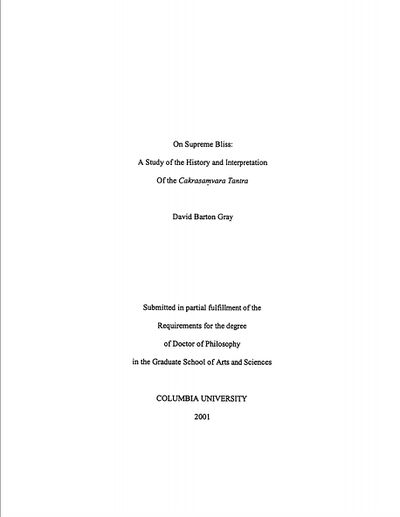On Supreme Bliss: A Study of the History and Interpretation of the Cakrasaṃvara Tantra
< Books
| Line 12: | Line 12: | ||
***{{i|2. Buddhist Origins|45}} | ***{{i|2. Buddhist Origins|45}} | ||
***{{i|3. Hindu Origins|53}} | ***{{i|3. Hindu Origins|53}} | ||
| + | |||
*{{i|2. Passion, Compassion and Self-Mastery: Approaches to Tantric Buddhism|65}} | *{{i|2. Passion, Compassion and Self-Mastery: Approaches to Tantric Buddhism|65}} | ||
| − | + | **{{i|1. Purity|66}} | |
| − | 2. Transformation and Perfection | + | **2. Transformation and Perfection |
| − | + | ***{{i|1. The Alchemy of Passion and Compassion|86}} | |
| − | 2. Union and Self-Consecration 95 | + | ***{{i|2. Union and Self-Consecration|95}} |
| − | 3. The Way of Great Bliss | + | **3. The Way of Great Bliss |
| − | 1. Joy and Asceticism | + | ***{{i|1. Joy and Asceticism|103}} |
| − | 2. Transgression and Self-Mastery | + | ***2. Transgression and Self-Mastery |
| − | 1. Interpretation and Ambiguity 113 | + | ****{{i|1. Interpretation and Ambiguity|113}} |
| − | 2. The Logic of Mastery 128 | + | ****{{i|2. The Logic of Mastery|128}} |
| − | 4. Concluding Models 147 | + | **{{i|4. Concluding Models|147}} |
| + | |||
3. Competing Discourses in Theory and Practice 152 | 3. Competing Discourses in Theory and Practice 152 | ||
I. The Discourse on V a.rr.ia | I. The Discourse on V a.rr.ia | ||
Revision as of 19:07, 19 March 2020
Abstract
This thesis explores the development of an important Indian Buddhist scripture. the Cakrasaṃvara Tantra, and the tradition of exegesis and practice based upon it. It consists of an edition and translation of the first four chapters of the Cakrasaṃvara Tantra, as well as a translation of the corresponding portion of Tsongkhapa's Total Illumination of the Hidden Meaning, a Tibetan commentary on this scripture. These texts are contextualized via efforts to define "Tantric Buddhism" as it is understood by the tradition itself, and via explorations of both the intellectual and socio-historical contexts within which Tantric Buddhism developed, and the ways in which different subtraditions within it were elaborated and categorized.
It is argued that a common element of Tantric traditions is their resistance to the hegemonic ideology of caste. An exploration of this ideology and Buddhist resistance to it is undertaken. Tantric discourse was deployed as a form of resistance against caste ideology, but also constituted a counter ideology, which centered around the figure of the guru as a nexus of power and authority, and articulated in the model of the maṇḍala.
The Cakrasaṃvara Tantra, is notable for the strong presence of "non-Buddhist elements." The Cakrasaṃvara Tantra, is a composite text drawing from diverse sources, and while it probably reached its final form in a Buddhist monastic context, there is significant textual evidence suggesting that it was the product of a non-monastic, renunciant milieu in which sectarian identification was not particularly relevant. The Cakrasaṃvara Tantra, is, in Levi Strauss' terms, a bricolage. It provides a particularly striking example of the processes of adaptation and reinterpretation which have continually led to the development of religious traditions. The Cakrasaṃvara's identification as a Buddhist tradition was the result of the efforts of commentators in India who constructed it as such, and by Tibetan commentators, who completed this process of adaptation.
| Citation | Gray, David Barton. "On Supreme Bliss: A Study of the History and Interpretation of the Cakrasaṃvara Tantra." PhD diss., Columbia University, 2001. |
|---|---|

